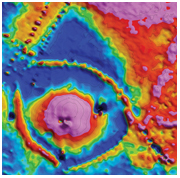
The supposed meteorite that supposedly caused the supposed “Sirente crater” in the Abruzzi mountains did not bring down the Roman Empire after all. Ted Nield reports.
Geoscientist Online 19 March 2009
In 2002, a 130m wide sub-circular depression with raised rims, lying in a karstic plain among the Abruzzi Mountains, shot to world fame on the basis of a scientific paper suggesting it was an impact crater. Seventeen similar depressions nearby (lacking the raised rim) were interpreted as part of a large strewn field, suggesting a shower of fragments had fallen from a massive bolide, “around 412AD”.
The story, based on a paper in
Meteoritics and Planetary Science, quickly grew in the telling. The supposed event was soon being related to a local legend dating from the late 19th Century, about local pagans long ago who had been miraculously converted to Christianity by a falling star over Sirente.
Before long, the supposed impact was being related to Emperor Constantine’s flaming cross, which he reputedly witnessed the day before his victorious battle against the pagan Maxentius in 312 AD. Because this was the event that eventually led to the conversion of the entire Empire (which, as Edward Gibbon made clear in his
Decline and Fall, was what lay behind the Empire's fatal weakening) before very long the media were attributing the collapse of Imperial Rome itself to cosmic impact.
As Salford University Space Technologist and sometime writer on things asteroidal Duncan Steel wrote in
The Guardian (6 February 2003):
“Rome of that era came close to suffering a far worse calamity. A small metallic asteroid descended from the sky, making a hypervelocity impact in an Apennine valley just 60 miles east of the city. This bus-sized lump of cosmic detritus vaporised as it hit the ground. In doing so, it released energy equivalent to around 200 kilotonnes of TNT: around 15 times the power of the atomic bomb that levelled Hiroshima in 1945.”
First the dinosaurs, then the Roman Empire. Was there anything that could not be explained by a load of bolides?
Bolides indeed
Well, sadly for this colourful story, scientists have now conclusively debunked the idea. The “Sirente Crater” turns out to be nothing more than a dew pond, excavated by shepherds probably during Roman times, for the watering of their animals in the dry karstic landscape. The regular need to de-silt the depression explains its raised rim: modern shepherds have been seen doing the same for other dew ponds in the area as recently as four years ago. It also explains the total lack of any corroborating evidence to have come to light since the idea was first floated by J A P Ormö et al. in their paper. Supposed magnetic anomalies tentatively linked to meteorite hit were discredited as being due to shrapnel and other bits of army ordnance which litter the area since World War 2.
In fact, since the original idea was published, not a single geochemical or geophysical anomaly, shocked mineral grain or siliceous spherule has come forward to support the idea. Now, geophysical surveys, conducted for the first time across the depression itself, have shown that the supposed crater shows no magnetic anomalies attributable to impact, and that there appears to be no disturbance at depth.
The lack of any roots to the “crater” also debunks another suggestion that had been put forward - namely that the depressions were the remnants of mud volcanoes. The geology of the area, as revealed at depth, is also inconsistent with this hypothesis.
Circumstantial evidence in favour of a “shepherdogenic” origin however is rather strong. All 20 or so sags now identified occur in dry karstic areas with consistent geology, while the annual sheep migration has been a characteristic of life in the Abruzzi for millennia. All the depressions contain lacustrine silts and all are fed by intermontane springs, some with aqueducts leading to them.
Refs
- Bondre, N 2009: Crater or not? Nature Geoscience 2 March 2009 p166
- Ormö J et al., 2002: The Sirente Crater Field, Italy. Meteorit. Planet. Sci., 37 1507-1521
- Speranza, F et al., 2004: An anthropogenic origin of the “Sirente Crater”, Abruzzi, Italy. Meteorit. Planet. Sci., 39, 4, 635-649
- Speranza, F et al., 2009: The “Sirente crater field”, Italy, revisited. JGR 114 (in press)